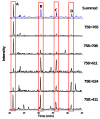Expediting the development of targeted SRM assays: using data from shotgun proteomics to automate method development
- PMID: 19326923
- PMCID: PMC2743471
- DOI: 10.1021/pr801028b
Expediting the development of targeted SRM assays: using data from shotgun proteomics to automate method development
Abstract
Selected reaction monitoring (SRM) is a powerful tandem mass spectrometry method that can be used to monitor target peptides within a complex protein digest. The specificity and sensitivity of the approach, as well as its capability to multiplex the measurement of many analytes in parallel, has made it a technology of particular promise for hypothesis driven proteomics. An underappreciated step in the development of an assay to measure many peptides in parallel is the time and effort necessary to establish a usable assay. Here we report the use of shotgun proteomics data to expedite the selection of SRM transitions for target peptides of interest. The use of tandem mass spectrometry data acquired on an LTQ ion trap mass spectrometer can accurately predict which fragment ions will produce the greatest signal in an SRM assay using a triple quadrupole mass spectrometer. Furthermore, we present a scoring routine that can compare the targeted SRM chromatogram data with an MS/MS spectrum acquired by data-dependent acquisition and stored in a library. This scoring routine is invaluable in determining which signal in the chromatogram from a complex mixture best represents the target peptide. These algorithmic developments have been implemented in a software package that is available from the authors upon request.
Figures







References
-
- Arnott D, Kishiyama A, Luis EA, Ludlum SG, Marsters JC, Jr, Stults JT. Mol Cell Proteomics. 2002;1:148–56. - PubMed
-
- Chang EJ, Archambault V, McLachlin DT, Krutchinsky AN, Chait BT. Anal Chem. 2004;76:4472–83. - PubMed
-
- Jin M, Bateup H, Padovan JC, Greengard P, Nairn AC, Chait BT. Anal Chem. 2005;77:7845–51. - PubMed
-
- Barnidge DR, Goodmanson MK, Klee GG, Muddiman DC. J Proteome Res. 2004;3:644–52. - PubMed
-
- Anderson L, Hunter CL. Mol Cell Proteomics. 2006;5:573–88. - PubMed
Publication types
MeSH terms
Substances
Grants and funding
LinkOut - more resources
Full Text Sources
Other Literature Sources

